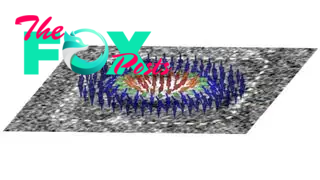Technology
Weird magnetic 'skyrmion' quasiparticle could be used as a bit in advanced computing memory
A bizarre type of magnetic quasiparticle that looks like a tiny, swirling bubble could one day be used as a computing bit in future memory devices after scientists sped it up enough to transmit data.
"Skyrmions" — informally called "nanobubbles" by the scientists — are formed of a few dozen atoms and are just a few nanometers in width. By contrast, a strand of human hair is up to 100,000 nanometers thick. A skyrmion generates itself from magnetic field lines as it moves through a medium. The quasiparticle comprises elementary nanomagnets, called spins, that wind together over the magnetic lines to form a whirling, spiral structure that resembles a tight knot.
Scientists have long theorized that skyrmions could potentially be used to store data — where the presence of a skyrmion will encode a 1 and its absence will encode 0. For instance, IBM researchers used skyrmions in a prototype device called "racetrack memory." Previous research has also identified them as a candidate for qubits, or quantum bits, in quantum computers.
In a new study, published April 19 in the journal Science, scientists argue that skyrmions can be used to store information in a new type of "universal memory." Such a component would combine the best of separate ones in computers today — namely, short-term memory, like random access memory (RAM), and flash memory, such as solid-state drives (SSDs) or hard drives.
RAM is fast but occupies a lot of space and needs a constant power supply, meaning data is wiped when a computer is turned off. Flash memory, meanwhile, is dense and can retain data without power, but its data transfer speeds are much slower than RAM. They all use electrons as bits.
Related: The 7 most powerful supercomputers in the world right now

In the new study, the researchers say skyrmions could be used in place of electrons as a new type of bit that could eliminate these limitations.
-

 Technology2h ago
Technology2h agoThere Is a Solution to AI’s Existential Risk Problem
-

 Technology5h ago
Technology5h agoUS pushes to break up Google, calls for Chrome sell-off in major antitrust move | The Express Tribune
-

 Technology9h ago
Technology9h agoPublic health surveillance, from social media to sewage, spots disease outbreaks early to stop them fast
-

 Technology10h ago
Technology10h agoTikTok, PTA host youth safety summit in Pakistan | The Express Tribune
-

 Technology14h ago
Technology14h agoWhy a Technocracy Fails Young People
-

 Technology1d ago
Technology1d agoTransplanting insulin-making cells to treat Type 1 diabetes is challenging − but stem cells offer a potential improvement
-

 Technology1d ago
Technology1d agoJapan's $26 billion deep sea discovery sparks serious environmental concerns | The Express Tribune
-

 Technology1d ago
Technology1d agoShould I worry about mold growing in my home?



























